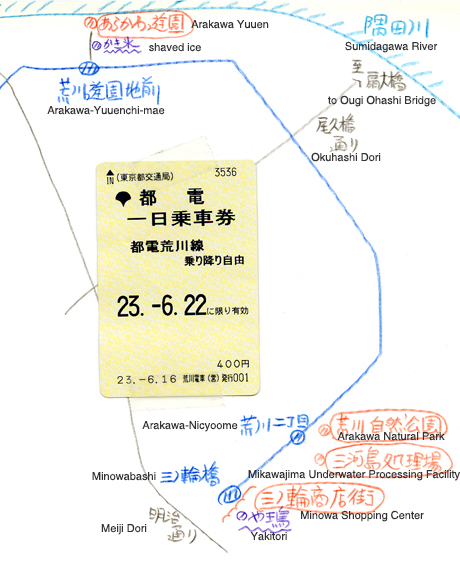

I've been living in Tokyo for 30 years, but there's something I haven't done yet. That is, riding the Toden and the Hato bus. The Toden is a train for residents. If I lived along the line, I must have been familiar with it. On the other hand, the Hato bus is completely for tourists, so I haven't even thought of riding it. Still, for someone (like me) who came to Tokyo from the country, the Toden is like streetcars in Hakodate, Hiroshima, or Matsuyama. You can enjoy the view and get off at any station that interests you. So, the Toden can be the best way of transportation for touring Tokyo with a camera. Today, I got an one-day pass (¥400) and have a short trip fro 12.2km from Minowabashi to Waseda. Of course, I plan to stop off at any station whenever the area looks interesting. (photo/text by Akio Inden)

I brought my LEICA M9 and the powerful Carl Zeiss Distagon T* 2.8/15 ZM and the first generation SUMMICRON 2/35. If you grab the Distagon 15mm, it feels hefty. But, once it's mounted on the M9, it feels and looks perfect. Ultra wide angle lenses can even capture your fingers if the barrel is short, but this one is long, so you don't have to worry about it.





My locations don't go well because of a deli like this. Both the wrapping paper and the taste were perfect.

I almost ordered a cup of sake, but was patient enough to start my photo walk. The Toden runs every few minutes. It's so peaceful, too peaceful! Anyway, let's get on board!


I wanted to take a look at the brick building, so I got off at Arakawa 2 choome station. According to the signboard at the station, this building is the first modern underwater processing facility and it's Tokyo's tangible cultural property. I wanted to shoot seriously, but it was surrounded by walls and I couldn't go inside. If this were on TV, a kind staff would show up and say, "please come in!" Well, there's no such possibility for Tokyo Exposure. But, if you make a reservation, you can go and take a look inside. Anyway, I got off here, so I decided to climb a hill to the Arakawa Natural Park shown on the guide map at the station (almost every station has great maps).

The Arakawa National Park is the largest park in the district. It has a variety of sports facility. In the Insect Observation park, you can take a look at Japanese beetles. Also, in the Giant Purple Butterfly Observation Park, you can check out giant purple butterflies (Japan's national butterfly). Note that butterfly observation is limited to the summer days from 6/17 to 7/24 on weekends and holidays. Riding a train is exciting for kids and they'll be more excited when you stop off sometimes. Plus, it offers full of interesting situation for adults as well.


The name of the station is Arakawa Yuuenchi, but this place is called "Kuritsu Arakawa Yuuenchi (Amusement Park)." It's run by the district and it's so simple unlike the nostalgic Hanayashiki in Asakusa.

The park has old playground equipment, fishing pond, and a place to play with water. But, on weekdays, large playground equipment were not being operated, so I couldn't see Sumidagawa River from the Ferris wheel. (Park admission is free on weekdays and there's a charge on weekends. But, if you show the one-day pass, it's free!)

From the station to the park's entrance, it takes 3-4 minutes by walking. On the way, you'll want to stop by at a nostalgic cheap sweets shop, a monja restaurant, a shaved ice café, and other interesting places. That's quite like a 60-year-old townscape that opened with the amusement park. Of course, this place is great for shooting.

 Attracted by the red letter "ice" on the white background, I got a shaved ice to go (¥200). I ordered the summery blue syrup asking him to pour plenty of it, and he smiled. On the park side, there're many trees to shield from the sun. So, I took a lunch break with the yakitori that I bought at the departure place, a beer, and the shaved ice. Of course, they made a perfect lunch.
Attracted by the red letter "ice" on the white background, I got a shaved ice to go (¥200). I ordered the summery blue syrup asking him to pour plenty of it, and he smiled. On the park side, there're many trees to shield from the sun. So, I took a lunch break with the yakitori that I bought at the departure place, a beer, and the shaved ice. Of course, they made a perfect lunch.

I really wanted to take close up shots with my LEICA lens, so I mounted it on the Olympus E-P series body with the adapter and I attached a close-up lens using a step-up ring. This 35mm SUMMICRON becomes a 70mm which is a perfect lens for shooting food. Also, this soft depiction is hard to replace.


The slow Toei Arakawa Line is perfect for Tokyo Exposure in terms of speed and sense of distance. But, there're too many attractive things to move forward... Maybe this is one of the first world problems... I haven't even reached at the half point, but I stop here for now. The latter edition will cover from Arakawa Syako Mae (The Toden's only train depot) to the last stop "Waseda."
